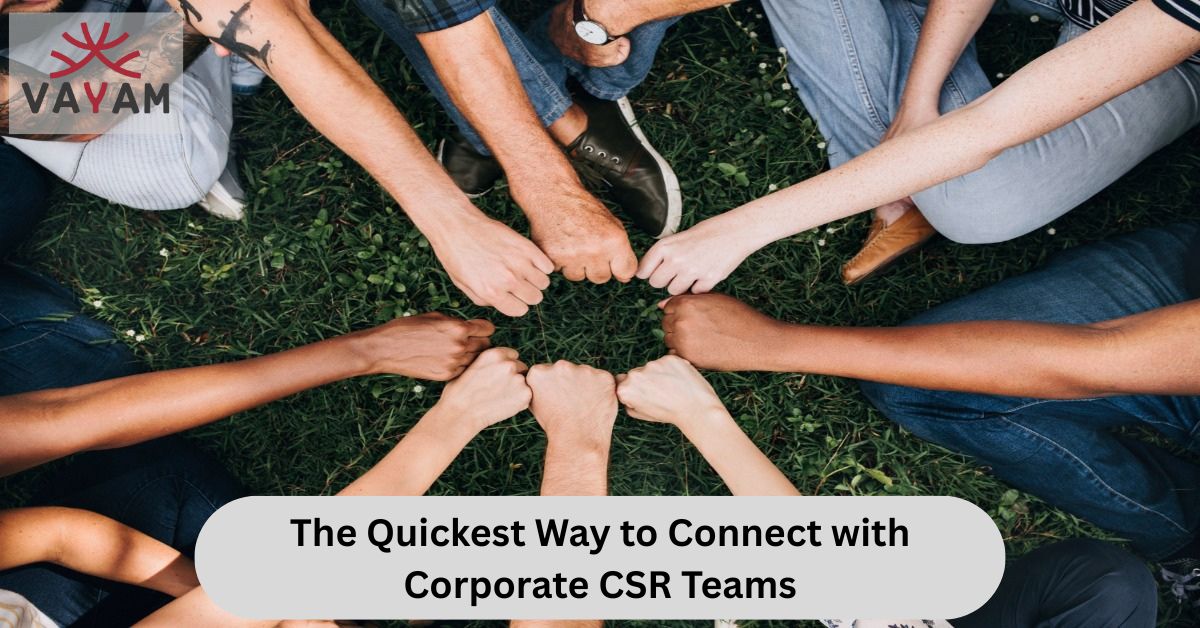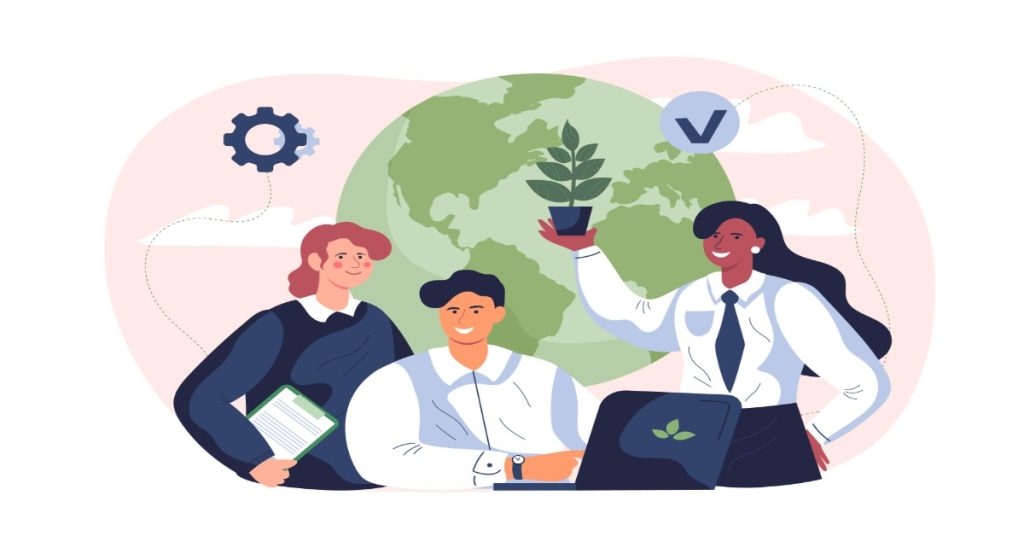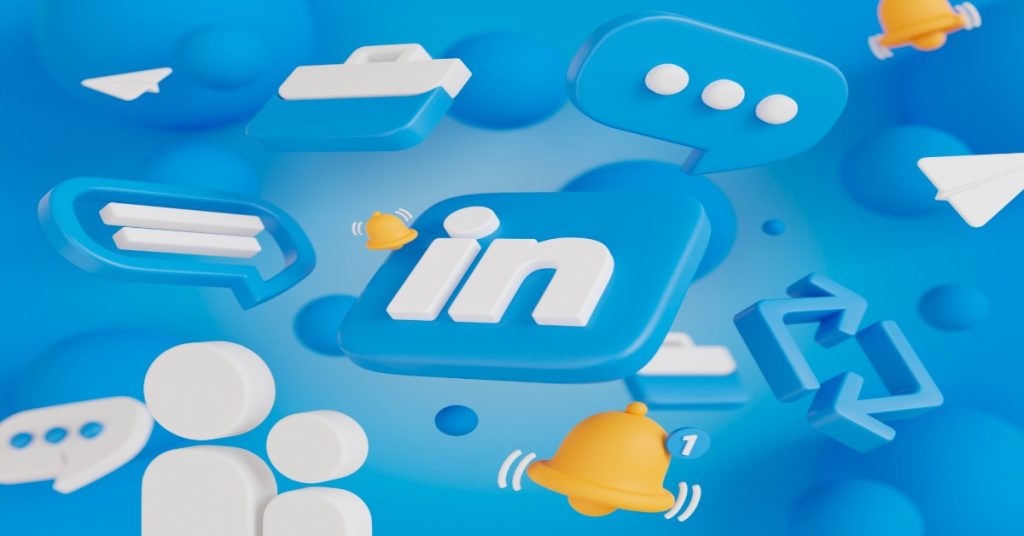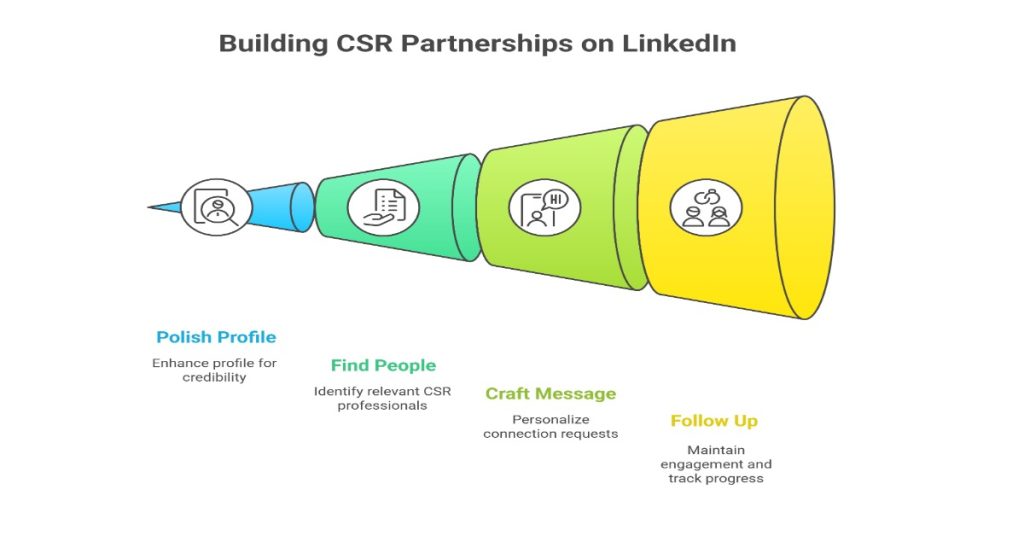
Have you ever stared at your inbox, wondering why that email to a corporate CSR manager vanished into the void? Or maybe you’ve spent hours crafting a pitch, only to get crickets in response? If you’re a nonprofit leader, startup founder, or anyone hoping to partner with big companies on social good projects, I get it reaching CSR teams feels like trying to flag down a speeding train. They’re busy, bombarded with requests, and often tucked behind layers of bureaucracy.
But here’s the good news: there’s a straightforward path to cut through the noise and land real conversations. In this post, we’ll walk through the quickest way to connect with corporate CSR teams using LinkedIn as your secret weapon. I’ll share the pain points you’re likely facing, practical steps to fix them, and tips to turn those connections into ongoing partnerships. By the end, you’ll have a game plan that saves time and gets results. Let’s dive in.
Why Bother Connecting with CSR Teams Anyway?
You’re running a community program that teaches kids coding skills, and you need funding or volunteers. Or perhaps your eco-friendly product line could align perfectly with a company’s sustainability goals. Corporate CSR (that’s Corporate Social Responsibility for the uninitiated) teams are the folks inside companies like Google, Unilever, or your local bank who handle these initiatives. They manage budgets for donations, employee volunteering, and cause-related marketing often in the millions.
Connecting with them isn’t just about a quick ask; it’s about building bridges that lead to repeated collaborations. Think grants that keep your lights on, co-branded events that boost your visibility, or even employee talent loans for your projects. According to recent reports from platforms like Cause IQ, companies spent over $20 billion on CSR in 2023 alone, with more pouring in each year as consumers demand purpose-driven brands.
The catch? These teams get hundreds of pitches weekly. If you’re not standing out, you’re just another email in the spam folder. That’s where the pain hits hardest—wasted effort and missed opportunities. But don’t worry; the fix is simpler than you think.

The Real Struggles: What’s Holding You Back from CSR Connections?
Let’s be real for a second. You’ve probably hit these walls before:
The Gatekeeper Gauntlet: Front-desk folks or assistants who screen every call and email, leaving you looping in voicemail hell.
Generic Pitches That Flop: Sending the same boilerplate message to everyone? It screams “I don’t care about you specifically,” and CSR pros can spot it a mile away.
Timing Troubles: CSR budgets often align with fiscal years or specific campaigns, but how do you know when to strike without insider info?
No Warm Intro: Cold outreach feels awkward, and without a mutual connection, trust is hard to build fast.
These frustrations add up, turning what should be an exciting outreach into a draining chore. I remember chatting with a friend who runs a women’s empowerment nonprofit—she spent months chasing a Fortune 500 CSR lead via email, only to learn later they preferred social channels. Sound familiar? The solution? Shift to a platform where decision-makers already hang out, sharing their wins and challenges openly.
Enter LinkedIn: Your Fast-Track Ticket to CSR Conversations
If email is a crowded highway, LinkedIn is the express lane. Why? It’s the go-to spot for professionals—over 1 billion users worldwide, with CSR managers actively posting about their work, joining groups, and responding to thoughtful messages. A quick scan shows execs from Patagonia to PepsiCo sharing CSR reports and seeking partners right there.
The quickest way? Personalized LinkedIn outreach. It takes under 30 minutes to set up a solid connection request, and with a smart follow-up, you could have a reply by week’s end. No more guessing games—you see their recent activity, like a post on diversity initiatives, and tie your message directly to it. This beats cold emails because it’s visual, immediate, and feels like a natural chat at a networking event.
Best part: It’s free (mostly), targeted, and measurable. Track who views your profile or engages with your content, then nurture those leads. Ready to make it happen? Let’s break it down step by step.

Step 1: Polish Your LinkedIn Profile Make Them Want to Know You
Before you send that first request, ask yourself: Does my profile scream “valuable partner” or “random spammer”? CSR teams vet connections quickly, so first impressions count.
Start with a clear headline. Ditch “Nonprofit Director” for something punchy like “Helping Companies Boost Community Impact Through Tech Education Programs | Partnered with IBM & Local Schools.” It shows results and relevance.
Your “About” section? Keep it short—three paragraphs max. Share your story in plain speak: “I started this work after seeing too many kids left behind in underfunded areas. Today, we train 500+ students yearly, and we’re looking to team up with forward-thinking companies like yours.” Include a call-to-action: “Let’s chat if your team is tackling skills gaps—message me!”
Add a professional photo (smiling, approachable) and a banner image that nods to your cause, like kids coding or a green initiative. List skills like “CSR Partnership Building” or “Impact Measurement” to pop up in searches. Finally, showcase endorsements and recommendations from past corporate collaborators. This builds instant credibility.
Pro tip: Update your profile with keywords like “CSR partnerships,” “corporate volunteering,” and “sustainability collaborations.” Search engines (and LinkedIn’s algorithm) love that for better visibility.
Step 2: Find the Right People—Research Like a Pro
Hunting for needles in a haystack? Not on LinkedIn. Use the search bar: Type “CSR Manager [Company Name]” or “Head of Sustainability [Industry].” Filter by location if needed, and switch to “People” view.
Aim for mid-level folks first—they’re more accessible than C-suite execs but still influential. Check their profiles for clues: Recent posts about employee giving days? That’s your in. Joined a group like “CSR Professionals Network”? Even better.
Tools like LinkedIn Sales Navigator (worth the $80/month if you’re serious) let you save searches and see who’s active. But even the free version works wonders. Spend 10 minutes per company jotting notes: Their pain points (e.g., “Struggling with volunteer retention”) and how you solve them.
Remember, quality over quantity. Target 5-10 people per week to avoid burnout.

Step 3: Craft a Message That Grabs Attention in Seconds
The golden rule: Keep it under 300 characters for connection requests, no essays here. Personalize like crazy. Generic “Hi, love your work” won’t cut it.
Template to tweak:
“Hi [Name], Saw your post on [specific topic, e.g., ‘reducing plastic waste in supply chains’]. Our [your org/project] has cut waste by 40% for similar partners. Would love to share how we could team up for coffee chat? [Your Name]”
Why this works: It shows you’ve done homework, offers value upfront, and ends with a low-pressure ask. Attach nothing yet save that for after they accept.
Once connected, send a thank-you note within 24 hours: “Thanks for connecting, [Name]! Quick question: What’s one challenge your CSR team is facing this quarter?” This flips the script from “me me me” to genuine curiosity.
Step 4: Follow Up Without Being Pushy—And Track Your Wins
No reply after a week? Don’t ghost—nudge gently. Comment on their next post: “Great insights on [topic]—reminds me of our work with [similar company].” Or share an article: “Thought this might interest you: [link to relevant study].”
Use LinkedIn’s reminders to stay organized. And celebrate small wins: A like, a view, or a “Thanks!” message means you’re on their radar.
If things stall, pivot. Ask for an intro: “Know anyone at [another company] who handles volunteering?” Networks grow networks.

Beyond LinkedIn: Quick Backup Plans for Deeper Reach
LinkedIn’s your MVP, but mix in these for variety:
Virtual Events and Webinars: Sites like Eventbrite or CSR Wire list free sessions. Attend, chat in the Q&A, and follow up on LinkedIn. It’s warm outreach on steroids.
X (Formerly Twitter) Chats: Search #CSR or #SustainabilityMonday. Reply to threads with your take—CSR folks love real-time engagement.
Smart Email as a Chaser: Got their work email from a company directory? Reference your LinkedIn connect: “Building on our chat about [topic]…” Short, sweet, and contextual.
Avoid mass blasts; focus on 2-3 touches per lead.
Turning Connections into Partnerships That Stick
Connecting is step one, staying relevant is the real game. Once you’re in, deliver value consistently. Share quarterly impact updates: “Our joint volunteer day reached 200 families here’s the data.” Invite them to low-key wins, like a virtual tour of your program.
Listen more than you talk. Ask about their goals: “How’s your DEI push going?” Tailor proposals to fit, like matching employee skills to your needs.
Over time, this builds trust. One connection I know turned a single LinkedIn message into a three-year grant because she followed through with results, not just asks.
Read More
How to Make CSR a Long-Term Revenue Stream for Your NGO
How to Maximize CSR Funding for Your NGO?
10 Proven Tactics to Secure Corporate Sponsorships for Your NGO
Wrapping It Up: Your Next Move to CSR Success
Reaching corporate CSR teams doesn’t have to be a slog. By zeroing in on LinkedIn with personalized, value-first outreach, you sidestep the usual headaches and spark real talks fast. Polish that profile, research smart, message with heart, and follow up like a pro. You’ll not only connect quicker but also create partnerships that drive real change—for your cause and theirs.
What’s stopping you? Pick one company today, find that CSR lead, and hit send. Share your wins (or questions) in the comments. I’d love to hear how it goes. You’ve got this.
